Overdentures: A Secure and Comfortable Solution for Missing Teeth
For many older adults, traditional dentures can feel loose, uncomfortable, and unreliable. Overdentures provide a more secure and natural-feeling alternative, improving confidence and quality of life.
Overdentures are a type of removable denture that is supported by dental implants, providing better stability and comfort compared to traditional dentures. By anchoring onto implants, overdentures help prevent bone loss, improve chewing efficiency, and enhance overall quality of life.
Traditional Dentures vs. Implant Dentures
Traditional Dentures:
- Rest on the gums, relying on suction or adhesives.
- Can slip or feel uncomfortable.
- May reduce chewing efficiency.
- Can contribute to bone loss over time.
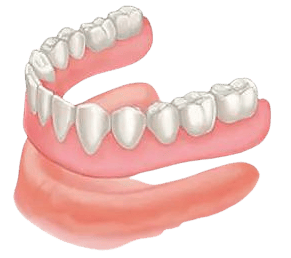
Implant-Supported Dentures:
- Securely attach to implants for improved stability.
- No need for adhesives.
- Help prevent bone loss.
- Provide better chewing ability and comfort.
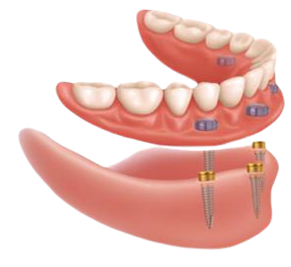
How Many Implants Are Needed?
The number of implants required depends on factors such as stability, bite force, and bone quality:
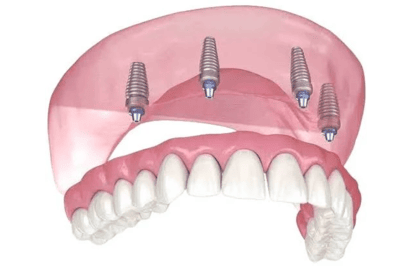
Upper Jaw: Minimum of 4 implants, but 4-6 provide enhanced stability. More implants result in a tighter, more stable denture.

Lower Jaw: Minimum of 2 implants, but 2-4 are recommended for better retention.
How Are Overdentures Connected to Implants?
Overdentures can be attached using different mechanisms:
- Ball Attachments – Small ball-shaped connectors that snap into place.
- Magnetic Attachments – Use magnets for retention.
- Locator Attachments – Offer secure yet easy removal for cleaning and maintenance.
Denture Procedure
Implant Supported Denture Procedure
- Treatment Planning – The process begins with a thorough consultation where your dentist evaluates your oral health, bone structure, and medical history. Digital scans or X-rays may be taken to assess the jawbone and determine the best implant placement strategy. A customized treatment plan is created based on your needs and preferences.
- Implant Placement & Immediate Denture – During the surgical phase, titanium implants are placed into the jawbone at predetermined locations. Depending on the case, a temporary denture may be provided so you can maintain function and aesthetics while healing. The surgery is typically performed under local anesthesia, but sedation options may be available for patient comfort.
- Healing Period – Over the next two to six months, the implants integrate with the jawbone through a process called osseointegration. This ensures a strong foundation for the overdenture. During this time, soft foods are recommended, and regular follow-ups are scheduled to monitor healing progress.
- Final Denture Connection – Once the implants have fully healed and integrated with the bone, the final overdenture is fabricated and connected. The denture is adjusted to ensure a secure, comfortable fit using locator attachments, a bar, or other retention mechanisms over the implants. Patients are guided on proper usage, removal, and maintenance for long-term success.
After-care Instructions & Maintenance for Overdentures
Daily cleaning is essential: remove the overdenture and clean it with a soft-bristled brush and non-abrasive denture cleaner. Brush your gums, tongue, and implants gently with a soft toothbrush to maintain oral hygiene. Soak your overdenture in a specialized denture solution overnight to keep it clean and free from bacteria.
Overdenture components (such as attachments and clips) wear down over time and require replacement every 6 months. Regular dental visits ensure optimal function and longevity of your overdenture.
Alternatives to Overdenture
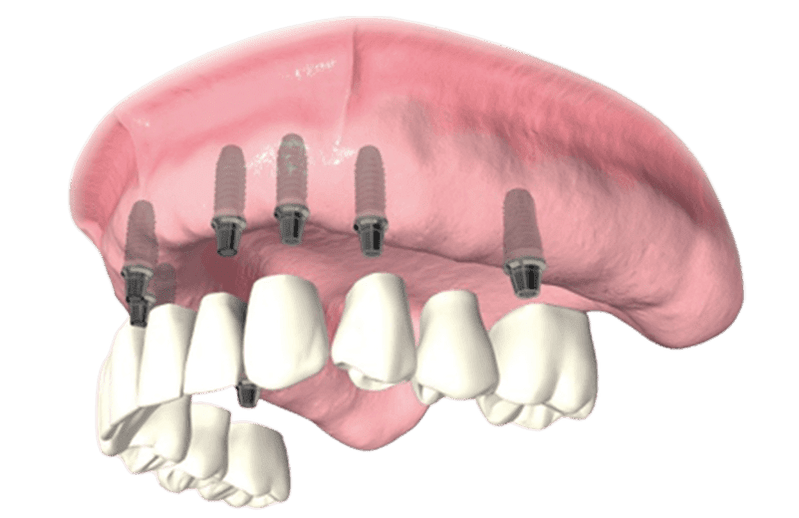
Full Mouth Bridge: Requires placing 6-8 implants, and 3-4 sets of dental bridges. This option provides the closest look and feel to having natural teeth, but is known to be more invasive, costly and requires more healing time.
Read More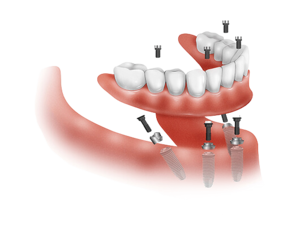
All On X: The All-on-X protocol involves placing 4-6 dental implants strategically into your jaw to securely anchor a full set of replacement teeth. The new set of teeth are placed and fixed on since your initial visit.
Read More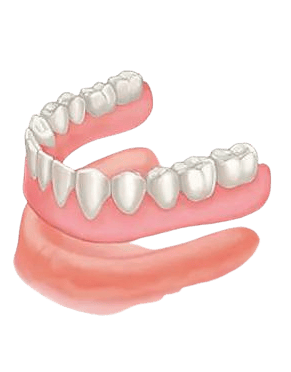
Removable Full Dentures: This is the conventional method of restoring full mouth missing teeth. Although these dentures are initially more affordable than All-on-X implants and are easier to modify and replace, they can shift, or feel loose or cause discomfort while eating. Overtime, with no tooth root present in the jaw bone, the bone will slowly recede, making it more difficult to place implants later. Patients are also recommended to avoid certain foods, use denture glue and ‘reline’ the dentures regularly to compensate the bone loss and regain the denture’s tightness.
Book an Appointment Now
You can simply email your inquiry along with a few clear photos of your
teeth to [email protected].
Our Dental Consultants will get back to you as soon as possible.
If you need immediate assistance, please call us directly at
(+66)2-402-9542,
or reach out to us on Whatsapp at
(+66)63-352-3691.
We’re here to make you smile again.





